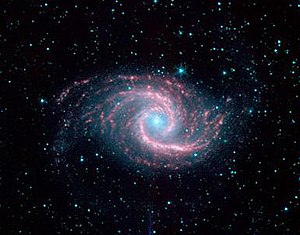Dorado Group
| Dorado Group | |
|---|---|
 |
|
| Observation data (Epoch J2000) | |
| Constellation(s) | Dorado |
| Right ascension | 04h 17m 03.9s |
| Declination | −56° 07′ 43″ |
| Brightest member | NGC 1566 |
| Number of galaxies | 46 plus 34 candidate members |
| Other designations | |
| Shk 18, G16, HG3, MC13, and NGC 1566 Group | |
The Dorado Group is a loose concentration of galaxies containing both spirals and ellipticals. It is generally considered a 'galaxy group' but may approach the size of a 'galaxy cluster'. It lies primarily in the southern constellation Dorado and is one of the richest galaxy groups of the Southern Hemisphere.Gérard de Vaucouleurs was the first to identify it in 1975 as a large complex nebulae II in the Dorado region, designating it as G16.
A rough distance estimate from NGC 1549 (using the Hubble constant as 70) put the cluster at 18.4 megaparsecs (Mpc). The Cepheid distance estimate from Freedman et al. 2001 is 15.3 Mpc. Based upon the 2001 work of Tonry et al. the surface brightness fluctuation (SBF) of six member galaxies was averaged and adjusted to estimate the group's distance at 19.1 ± 0.8 Mpc in 2007.
At the center of the cluster lie interacting galaxies NGC 1549 and NGC 1553. The dominant group members, ordered by luminosity, are: spiral NGC 1566, lenticular NGC 1553, and elliptical NGC 1549. The group spans an area of the sky 10° square, corresponding to an actual area of around 3 Mpc square. The group exhibits a relatively small harmonic mean radius (230 ± 40 kpc) due to the concentration at its core of more luminous galaxies. All together, the group has an overall luminosity of 7.8 ± 1.6 ×1010L⊙.
The Dorado Group contains three dominant smaller groups within itself, NGC 1672 Group, NGC 1566 Group and the NGC 1433 Group, as evidenced by the H I distribution of the region. The Dorado Group is in the Fornax Wall that connects these three groups. Duento its location in the Fornax Wall, the group is at a similar distance as the Fornax Cluster. The Dorado Group is richer than the Local Group, while still being dominated by disk types of galaxies (i.e. its two brightest members are spiral NGC 1566 and lenticular NGC 1553) and its member galaxies have H I masses on par with non-interacting galaxies of the same morphological type. With the group's apparent crossing time being 12.6 ± 0.6 % of the universe's age, recent analyses deduce that the group is unvirialized, and thus this may explain the abundance of spirals and H I.
...
Wikipedia
